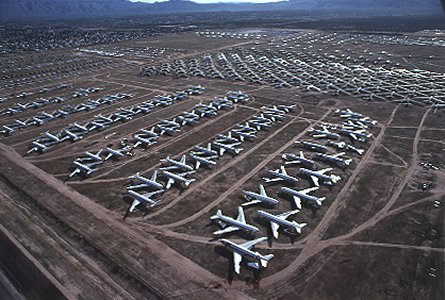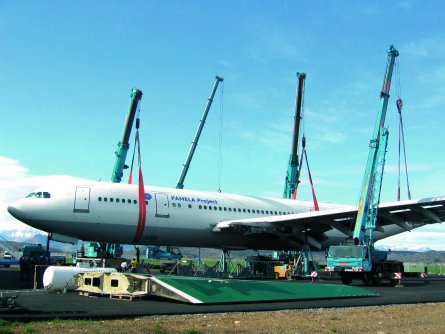Rob Coppinger in London
Over the next 17 years around 4,000 airliners are expected to be retired, with their material content measured in tens of millions of dollars. With some 200 commercial aircraft reaching the end of their lives every year, storage fields are becoming increasingly crowded, but the huge potential asset value represented by the ranks of retired jets is attracting interest.
|
| With the rising cost of raw materials, attention is turning to the recycle value of the 200 aircraft being retired every year |
Aircraft disposal is the subject of two projects led by Airbus and Boeing. The European manufacturer is leading research to develop procedures for the environmentally responsible decommissioning of airliners, while its US rival has formed a coalition to develop industry standards for the disassembly of aircraft, salvaging of parts and recycling of material.
Airbus is leading the European Union’s €4.3 million ($5.4 million) Process for Advanced Management of End of Life of Aircraft (PAMELA) project, which started in March 2005 and ends in October 2007. PAMELA was brought about by the EU’s end-of-life directive, adopted in late 2000, which sets out requirements for disposing of vehicles.
Funded 53% by industry and 47% by the EU’s LIFE (L’Instrument Financier pour l’Environment) programme, the PAMELA project aims to develop aircraft disposal procedures that comply with the environmental and health rules enshrined in the European Aviation Safety Agency’s Part 145 standards for maintenance operations and organisations.
Airbus is leading PAMELA as part of a commitment to taking cradle-to-grave responsibility for its products. Since the first A300B2 entered service 32 years ago, the manufacturer has taken orders for more than 6,000 aircraft from 200 customers, and is now preparing to help dispose of them. “The PAMELA project is a time-limited demonstration that aims to set up innovative and environmentally friendly, safe practices for management of the end-of-life of aircraft, with the objective to recycle 85-95% of the aircraft parts,” says Airbus. Today 60% of an aircraft, essentially its aluminium structure, can be recycled and PAMELA aims to increase that to 95% by 2015.
Introduced by Boeing in late April, the Aircraft Fleet Recycling Association (AFRA) aims to provide owners of aircraft with an integrated fleet management process. “The EU [directive] has not spurred AFRA’s creation; it’s about getting companies to operate more efficiently,” says Bill Carberry, Boeing’s aircraft and composite recycling project manager.
“We want to reclaim composite material and recycle fibres to flow that into high value reuse, not low value,” says Carberry. High value includes the use of recycled carbonfibre for aircraft parts such as tray tables, while low value includes the incorporation of reclaimed fibre in material for road construction.
Ethical basis
For the immediate future, AFRA’s primary objectives are to develop a code of conduct for retired aircraft management, establish next-generation standards and practices within a year of the code’s launch, and then expand those standards through AFRA. “The basis of the association [for now] is ethical, in dealing with how we work with each other and how we deal with the problem at hand,” says John Davidson, managing director of UK carbonfibre recycling specialist and AFRA member Milled Carbon. Later on, the industry group will focus on recycling technologies for the improved recovery of aluminium and precious metals and the recycling of carbonfibre.
Airbus expects PAMELA to go further and produce recommendations for future aircraft design processes; as well as create a new standard for decommissioning, storage, disassembling and dismantling, and recycling or elimination of an aircraft parts. “[PAMELA] should also provide some additional recommendations to better introduce environmental considerations at the earliest design stage of the aircraft,” the manufacturer says.
|
| The PAMELA project at Tarbes in France hopes to kick start interest in aircraft component recycling |
The PAMELA partners are using a General electric CF6-50C2-powered Airbus A300B2-200, registered TC-FLF, as the test vehicle for disassembling and dismantling. The aircraft entered service in 1982 and accumulated 53,489 flight hours before being retired. Dismantling will involve the removal of materials considered hazardous and polluting, including hydraulic fluid and residual fuel, while disassembling will involve the identification of equipment or parts that are in good condition or can be repaired for reuse. “The possibility of the components being reused depends on the type and the age of the aircraft and its related parts, and will be managed according to applicable regulations and standards,” says the European airframer.
Airbus’s partners are waste management firm SITA, maintenance company EADS Sogerma Services, the EADS Corporate Research Centre in France and the regional government of Hautes-Pyrenees. SITA will manage dismantling operations such as the cutting, sorting and recovery of metals, which will be recycled on the secondary raw materials market or re-integrated into the production cycle. The company has developed processes to separate composite, copper and plastic constituents and to remove electrical wiring insulation.
Manageable sections
The partners have set up a special centre for PAMELA at Tarbes airport in south-west France, within the Hautes-Pyrenees prefecture. There the engine pylons, landing gear, avionics boxes, flight controls, batteries and hydraulic pumps will be removed and the airframe divided into manageable sections. PAMELA partners hope the project will produce a European network to disseminate the process.
But Airbus is not predicting a rapid expansion of the aircraft recycling industry in Europe, saying: “The lessons learned will have to be considered before any possible further industrial development.” Project work underway includes an economic and market analysis of aircraft disposal, in which “the scarcity of some extracted raw materials would certainly play a key role in the business analysis”, the manufacturer says. Although aircraft engines may seem reusable, their recycling is not included in the project.
The AFRA coalition has two locations: Chateauroux Air Centre in central France, south of Paris, and Evergreen Air Center in Marana, northwest of Tucson, Arizona. Chateauroux airport offers a 4,900m2 (16,000ft2) hangar and a one-stop shop for the storage, maintenance, painting, parting out and scrapping of aircraft. On site are maintenance company Europe Aviation and scrapping specialist Bartin Recycling Group, both AFRA members.
Although AFRA is led by an American firm, Chateauroux airport strategy development manager Martin Fraissignes expects the association’s work to “help with future European legislation”. Nor does he rule out working with PAMELA participants, saying: “Maybe we’ll cooperate [with Tarbes].”
Other partners in AFRA are Albuquerque, New Mexico-based polymer specialist Adherent Technologies; Air Salvage International, a UK-based aircraft disassembly and parts recovery firm; WINGNet, a UK aerospace consortium focused on the sustainable use of materials; and Tucson- based recycling company Huron Valley Fritz West. Together, the AFRA members have experience in all aspects of managing an aircraft’s retirement, from re-sale to refurbishment, disassembly and recycling.
“The recycling industry is an ever-changing business due to its direct reliance on raw supply and demand of the commodity products it produces,” says Barry Fleet, vice president of marketing and sales for Huron Valley Fritz West. Higher material prices can justify the costs of dismantling and “scrap metal prices are at historical highs and the economists suggest there is room for the prices to increase”, he says. “As the world economy continues to grow, recycling will remain healthy.”
Engine manufacturer Rolls-Royce is in talks to join AFRA, which will launch operations in Chateauroux on 1 June. Boeing’s Carberry expects R-R to be the first of many. “We expect to double our membership in the next year”, he says, adding that Airbus is also eligible to participate. ■
Source: Flight International

























